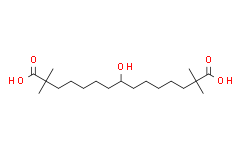| Description: |
ETC-1002(ESP-55016) is a novel, first-in-class, orally available, once-daily LDL-C lowering small molecule; activator of hepatic AMP-activated protein kinase (AMPK); also has potent inhibitory activity against hepatic ATP-citrate lyase(IC50=29 uM).
in vitro: ETC-1002 free acid activates AMP-activated protein kinase in a Ca(2+)/calmodulin-dependent kinase β-independent and liver kinase β 1-dependent manner, without detectable changes in adenylate energy charge. Furthermore, ETC-1002 is shown to rapidly form a CoA thioester in liver, which directly inhibits ATP-citrate lyas. In cells treated with ETC-1002, increased levels of AMP-activated protein kinase (AMPK) phosphorylation coincided with reduced activity of MAP kinases and decreased production of proinflammatory cytokines and chemokines .
in vivo: Activation of hepatic AMPK with ETC-1002 treatment from the two-week Wistar rat study was not associated with altered hepatic AEC. however, ETC-1002 treatment coincided with a 70% reduction in hepatic TG, while low basal levels of CE and FC remained insensitive to treatment. Importantly, reductions in liver TG content was accompanied by 51% increase in plasma β-HBA, indicating enhanced liver fatty acid β-oxidation . ETC-1002 suppressed thioglycollate-induced homing of leukocytes into mouse peritoneal cavity. Similarly, in a mouse model of diet-induced obesity, ETC-1002 restored adipose AMPK activity, reduced JNK phosphorylation, and diminished expression of macrophage-specific marker 4F/80.
For the detailed information of Bempedoic Acid(ETC-1002;ESP-55016), the solubility of Bempedoic Acid(ETC-1002;ESP-55016) in water, the solubility of Bempedoic Acid(ETC-1002;ESP-55016) in DMSO, the solubility of Bempedoic Acid(ETC-1002;ESP-55016) in PBS buffer, the animal experiment (test) of Bempedoic Acid(ETC-1002;ESP-55016), the cell expriment (test) of Bempedoic Acid(ETC-1002;ESP-55016), the in vivo, in vitro and clinical trial test of Bempedoic Acid(ETC-1002;ESP-55016), the EC50, IC50,and affinity,of Bempedoic Acid(ETC-1002;ESP-55016), For the detailed information of Bempedoic Acid(ETC-1002;ESP-55016), the solubility of Bempedoic Acid(ETC-1002;ESP-55016) in water, the solubility of Bempedoic Acid(ETC-1002;ESP-55016) in DMSO, the solubility of Bempedoic Acid(ETC-1002;ESP-55016) in PBS buffer, the animal experiment (test) of Bempedoic Acid(ETC-1002;ESP-55016), the cell expriment (test) of Bempedoic Acid(ETC-1002;ESP-55016), the in vivo, in vitro and clinical trial test of Bempedoic Acid(ETC-1002;ESP-55016), the EC50, IC50,and affinity,of Bempedoic Acid(ETC-1002;ESP-55016), Please contact DC Chemicals. |
| In Vivo: |
A marked and sustained increase in AMPK and ACC phosphorylation is found in rat livers following two weeks of treatment with ETC-1002. ETC-1002 free acid is >100-fold more prevalent than the CoA thioester in rat liver and is associated with AMPK activation[1]. ETC-1002 suppresses thioglycollate-induced homing of leukocytes into mouse peritoneal cavity. In a mouse model of diet-induced obesity, ETC-1002 restores adipose AMPK activity, reduces JNK phosphorylation, and diminishes expression of macrophage-specific marker 4F/80[2]. |
| In Vitro: |
ETC-1002 free acid activates AMP-activated protein kinase in a Ca2+/calmodulin-dependent kinase β-independent and liver kinase β 1-dependent manner, without detectable changes in adenylate energy charge. ETC-1002 is shown to rapidly form a CoA thioester in liver, which directly inhibits ATP-citrate lyase[1]. In cells treated with ETC-1002, increased levels of AMP-activated protein kinase (AMPK) phosphorylation coincide with reduced activity of MAP kinases and decreased production of proinflammatory cytokines and chemokines[2]. |
| Kinase Assay: |
7.5× compounds are added to a 96-well PolyPlate containing 60 μL of Buffer per well with substrates CoA (200 μM), ATP (400 μM), and [14C]citrate. Reaction is started with 4 μL (300 ng/well) ACL, and the plate is incubated at 37°C for 3 h. |
| Cell Assay: |
Glucose production is measured in primary rat hepatocyte cultures. Cells are cultured in glucose- and phenol red-free DMEM, containing 10 mM lactate, 1 mM pyruvate, and nonessential amino acids. Cells are incubated with and without 0.3 μM glucagon with various concentrations of ETC-1002 (0.1 to 100 μM). Cells are washed twice in GPB. Cells are then incubated for an additional hour to assess glucose production by adding GPB containing equivalent glucagon concentrations without ETC-1002. Cells are incubated for 1 h, and the concentration of glucose in the media is determined[1]. |
| Animal Administration: |
Rats: Prior to single-dose ETC-1002 administration, Male Wistar Han rats are fasted for 48 h and refed a high-carbohydrate diet for an additional 48 h. For two-week assessment, rats are maintained on standard chow diet and dosed by oral gavage with ETC-1002 at 30 mg/kg/day for two weeks in the morning. Following nutritional staging and/or dosing, food is withdrawn 2 h prior to last the oral dose of ehicle control or ETC-1002 [1]. |
| References: |
[1]. Pinkosky SL, et al. AMP-activated protein kinase and ATP-citrate lyase are two distinct molecular targets for ETC-1002, a novel small molecule regulator of lipid and carbohydrate metabolism. J Lipid Res. 2013 Jan;54(1):134-51.
[2]. Filippov S, et al. ETC-1002 regulates immune response, leukocyte homing, and adipose tissue inflammation via LKB1-dependent activation of macrophage AMPK. J Lipid Res. 2013 Aug;54(8):2095-108. |

 DC Chemicals' products qualify for U.S. tariff exemptions. We guarantee no price increases due to customs duties and maintain stable supply, continuing to deliver reliable research solutions to our American clients.
DC Chemicals' products qualify for U.S. tariff exemptions. We guarantee no price increases due to customs duties and maintain stable supply, continuing to deliver reliable research solutions to our American clients.





















